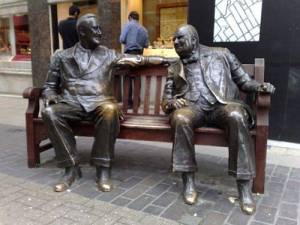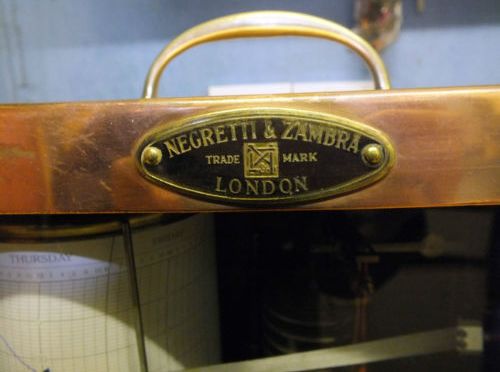There was a time when not too far from the hustle and bustle of Selfridges, Harvey Nicks and Fortnum & Mason stood a fine scientific instrument supplier.

Negretti & Zambra, at No. 122 Regent Street and later at No. 15 New Bond Street, specialised in barometers and thermometers – everything you could need to set up a weather station. The brand among weather anoraks is the byword for quality. The company, along with Short & Mason, probably made the majority of barometers that adorn many hallway walls across Britain. Next time you visit old aunt Flo or uncle Albert chances are the barometer hung on the wall is made by one of these companies.
Enrico Negretti and Joseph Zambra started their company in 1850, which was run by them and their descendents until well after the Second World War. They had shops firstly in Regent Street and later at Holborn Viaduct. The company was highly successful, winning a medal at the Great Exhibition in 1851, counting among their customers the Astronomer Royal, Prince Albert, the Royal Observatory and Admiral Robert Fitzroy.
Initially they specialised in barometers and thermometers, particularly those needed for taking deep sea and atmospheric measurements, which until they arrived were very unreliable. Later they increased their range to include telescopes, gun sights, theodolites and optical instruments. During the Second World War Negretti expanded substantially to meet the demand for instruments for war planes in particular. Their instruments were also produced under licence to supply the USAAF.

Go to No.122 Regent Street today and you’ll find a branch of the Body Shop. The shop at No.15 New Bond Street, which closed in 1975, 11 years after the company moved production to a factory in Aylesbury, is now a branch of watchmaker Patek Philippe. Outside you will find seated bronze statues of Allied wartime leaders Sir Winston Churchill and Franklin D. Roosevelt sharing a joke. The statue by Lawrence Holofcener was unveiled in 1995 by the Bond Street Association to mark 50 years of peace. I’m not sure how intentional this was but how fitting that they are outside Negretti’s old shop, the instruments of which played a big part in helping the Allies to prevail over the Axis.
Back in the day N&Z was highly regarded in the local community and people would phone to access data that the company compiled from its rooftop weather station. In the late 1950s it was the job of Geoffrey John Gill, an office junior who went on to become an apprentice draftsman, to collect these stats.
“I was getting tea, coffee and buns from a Greek cafe in Soho’s Wardor Street for the office staff, collecting the mail and using the franking machine and last but not least the holy of holy’ climbing to the shop roof top and collecting the charts from the sunshine glass ball recorder, the rain gauge, barograph and the hygrometer box. You see it was common in those days for people to phone N&Z to enquire what these readings had been for the past day or so, a typical quality N&Z service.” A full account of his time with the company can be found here.

Short & Mason were established five years prior to Negretti in 1845 by Thomas Short and James Mason. The business was located at 40 Hatton Garden, London, and produced precision measuring instruments including barometers, anemometers, and compasses. They became leaders in the field of barograph design and supplied scientific instruments for the Scott and Shackleton polar expeditions in the early 20th century and for Everest climbers.
In 1910 the company relocated to Macdonald Road, Walthamstow. It was here that 11 years later the company pioneered the theory that a storm forecast could be made from just observing the air pressure and whether it was rising or falling. The company went on to develop aeronautical, medical, meteorological and surveying instruments and were listed exhibitors at the British Industries Fair in 1922 and 1947.
In 1958 the business moved to Wood Street, Walthamstow, where it continued to trade until a merger in 1969 with Taylor Instrument Companies, of Leighton Buzzard, Beds. An account of somebody with experience of working for Short and Mason can be found here.
Many examples of Negretti & Zambra and Short & Mason instruments can be found on eBay and antique shops across the world, the finer examples often turn up at auction houses such as Bonhams where they go for thousands of pounds.
Though, like many industries, weather observing has become mostly automated there are are still probably hundreds of observers who still take the manual measurements every morning ‘because they can’. Though this observer relies on an automatic weather station for daily readings – there is nothing like the daily ritual of emptying the Snowdon raingauge or shaking down the maximum thermometer at 0900 GMT every day. One observer who still supplied the Met Office with monthly rainfall readings while in his 80s said that it was the one thing that got him out of bed every morning.

Perhaps it’s a little similar to the ever growing popularity of classic cars. A sense of being able to hold a piece of British engineering history that was so well designed that it still works today.

You must be logged in to post a comment.